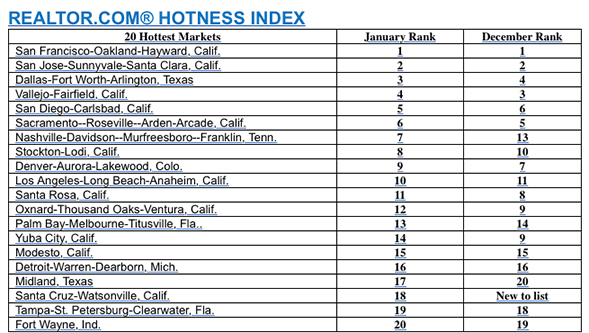 Economic uncertainty driven by a tumultuous start of the year for financial markets does not seem to be dampening the pent-up demand that drove growth and sales in 2015. Instead, year-over-year trends point to this spring being the busiest since 2006, according to the analysis of preliminary January data on realtor.com.
Economic uncertainty driven by a tumultuous start of the year for financial markets does not seem to be dampening the pent-up demand that drove growth and sales in 2015. Instead, year-over-year trends point to this spring being the busiest since 2006, according to the analysis of preliminary January data on realtor.com.
The residential real estate market is following a typical January pattern, with cooler demand, reduced inventory and slower market velocity than during warmer months in most markets. Despite these monthly trends, 2016 is off to a strong start with robust year-over-year growth. January median list prices are expected to show a substantial increase of 8 percent year over year, despite a slight decrease from December. Homes are selling 4 percent faster this year when compared to last year. Yearly inventory is 1,510,329. On a monthly basis, inventory continues its seasonal decrease so buyers see fewer total choices but face less competition for the supply on the market.
“Our initial readings on January affirm the positive growth we expect to see in the residential real estate market in 2016,” says Jonathan Smoke, chief economist of realtor.com. “Our traffic, searches and listing views exhibited the January ‘pop’ we saw last year, which made for a strong spring. In addition, a large number of prospective buyers have been telling us since the second half of 2015 that they plan to purchase in the spring and summer of 2016.
All indicators point to this spring being the busiest since 2006, but we’ll need to see inventory grow more robustly this year to satisfy these buyers,”adds Smoke. “The decline in the stock market so far seems to be a net positive for real estate demand. Fixed 30-year mortgage rates are now about 25 basis points lower than at the end of 2015 as a result of the financial market weakness. That extra buying power appears to be offsetting any weakness from buyers whose stock-related losses impair their ability to buy.”
Key Statistics:
- Listing inventory is expected to be 1,510,329 on a yearly basis and trend down 7 percent over December, following the typical winter pattern. Inventory is moving 4 percent faster than last year at 100 days on the market; 6 percent slower than December.
- Median listing price for January is estimated at $227,000 an increase of 8 percent year over year and virtually flat over last month
- Realtor.com’s ‘Hottest Markets’: From the demand side, these markets receive 2 – 5 times the number of views per listing compared to the national average. From the supply side, these markets are seeing inventory move 30-50 days more quickly than the rest of the U.S. They have also seen days on market drop by a combined average of 7 percent year-over-year.

For more information, visit www.realtor.com.










